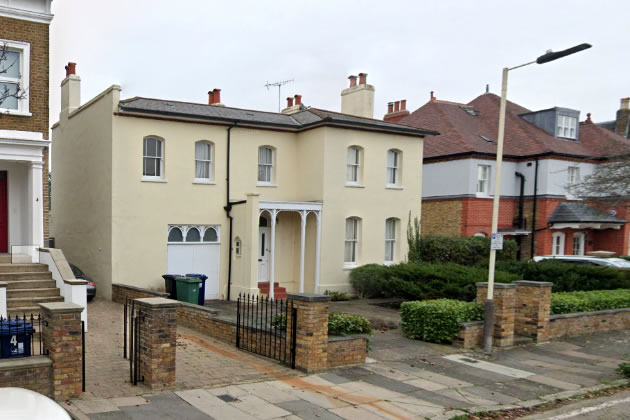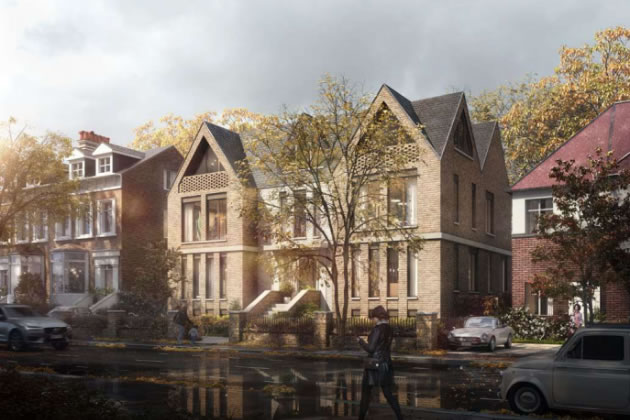Hundreds Object To Demolition of Historic Ealing House
One of oldest houses in the area could be developed into flats

The house threatened with demolition on Marlborough Road. Picture: Google Streetview
January 26, 2023
Over 300 objections have been made to a proposal to knock down a house in Ealing which dates back to the mid-19th century making it one of the earliest surviving homes in the area.
The property at 6 Marlborough Road was built in the original centre of Ealing around St. Mary’s Church and was originally called Clive Lodge. It was the first house to be built on the road has been locally listed on the council’s heritage asset register since 2014.
The site is on the north side of the road in a wide plot with a large rear garden. A plan (225185FUL) has been submitted to the council to knock down the building and replace it with a development of 8 self contained flats, 6 two bedroom and one each three and one bedroom in a four storey block.
The application acknowledges the unusual fretwork detailing to the recessed porch and to garage fanlights which is mid Victorian but argues that any heritage loss is outweighed by the extra provision of housing. It is claimed that the current house, which is divided into two flats, has expanded significantly from the original square design of the property.
A heritage report submitted with the application concludes about the changes, “This results in a minor architectural and historic interest. The overall evidential interest of the building is reduced following the successive alteration, reducing the illustrative interest of the building in terms of the embodiment of contemporary building materials and construction techniques.”
The building is not in a Conservation area nor subject to an Article 4 Direction and a local listing does not qualify as a Statutory Listing.
A Planning Statement by estate agent Savills on behalf of the applicant Mountbatten Homes says, “The comprehensive and detailed submission demonstrates clearly, in our view, that the submitted scheme proposals should be supported. It accords with planning legislation and guidance at local, regional and national levels; and the development proposals make effective use of a highly sustainable site, embrace high quality design principles, and have been developed by paying close attention to detail in its aesthetic composition in terms of its immediate and wider townscape.”
 CGI of Proposed Scheme. Picture: Red + White, 2022
CGI of Proposed Scheme. Picture: Red + White, 2022
In pre-application meeting with council planners, it was made clear to the applicant that the building had heritage value and would not be demolished unless a strong case could be made. The applicant says it has revised its original plans and that its Heritage Statement demonstrates that the benefit of its proposal justifies the loss of the building due to the wider public benefits. It is pointed out that the new flats would result in an intensification of the site and contribute positively towards the Council’s Housing Targets.
A group of residents, who have been advised by Victor Mishiku of The Covenant Movement, has written a letter to the developer, the freeholder and others involved in the scheme which argues that the proposed development would be in breach of the covenant under which the land was originally granted. These documents were found during earlier investigations when a development was proposed on Ranelagh Road. The letter states, “Houses in Marlborough Road as well as in Liverpool Road, Ranelagh Road, Richmond Road, Blandford Road and parts of Warwick Road (formerly known as Guy’s Lane) were all part of a uniform building scheme with restrictions and covenants as to the kind of buildings that were intended to be permitted on the land which in the early 1850s was laid out and carefully planned as ‘The Rectory Estate, Ealing, Middlesex’. Lots on the estate which numbered 161 Lots, were part of a Scheme of Development administered by an Executive Committee enrolled as a benefit building society.
“Apart from 12 of the Lots on the Estate, only detached or semi-detached houses were to be built, one on each Lot and with the Vendor’s consent, one detached house could be built on two or more plots to provide a more spacious layout to the property. All of the Deeds relating to the 161 Lots are recorded at HM Land Registry and there are 7 paragraphs of restrictions and covenants registered against each Lot in accordance with a Deed of Mutual Covenant dated 4th June 1853. On the vast majority of ‘The Rectory Estate’ these covenants have been observed and the immediate neighbourhood is well ordered.”
Ealing Civic Society has also voiced its opposition to the scheme. It says, “The society is supporting many local residents appalled at this proposal to demolish a unique building of local heritage importance, that could be sensitively updated as a family home or even converted to a small number of distinctive flats. Apart from the loss of the heritage asset, the proposed new building is not environmentally sustainable, includes a proposed basement in an area of known problems with underground water sources and would appear over dominant within its plot. The design, which includes overlarge front and side gables, is also not sympathetic to the location.”
The application, reference 225185FUL, can be accessed here.
Like Reading Articles Like This? Help Us Produce More This site remains committed to providing local community news and public interest journalism. Articles such as the one above are integral to what we do. We aim to feature as much as possible on local societies, charities based in the area, fundraising efforts by residents, community-based initiatives and even helping people find missing pets. We’ve always done that and won’t be changing, in fact we’d like to do more. However, the readership that these stories generates is often below that needed to cover the cost of producing them. Our financial resources are limited and the local media environment is intensely competitive so there is a constraint on what we can do. We are therefore asking our readers to consider offering financial support to these efforts. Any money given will help support community and public interest news and the expansion of our coverage in this area. A suggested monthly payment is £8 but we would be grateful for any amount for instance if you think this site offers the equivalent value of a subscription to a daily printed newspaper you may wish to consider £20 per month. If neither of these amounts is suitable for you then contact info@neighbournet.com and we can set up an alternative. All payments are made through a secure web site. One-off donations are also appreciated. Choose The Amount You Wish To Contribute. If you do support us in this way we’d be interested to hear what kind of articles you would like to see more of on the site – send your suggestions to the editor. For businesses we offer the chance to be a corporate sponsor of community content on the site. For £30 plus VAT per month you will be the designated sponsor of at least one article a month with your logo appearing if supplied. If there is a specific community group or initiative you’d like to support we can make sure your sponsorship is featured on related content for a one off payment of £50 plus VAT. All payments are made through a secure web site. |